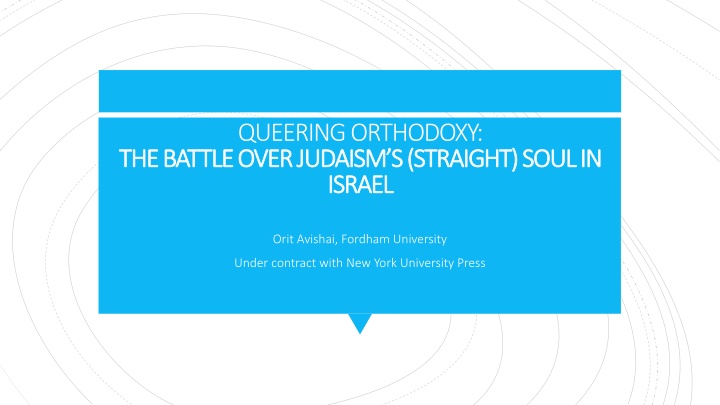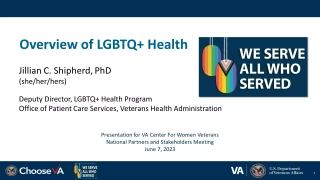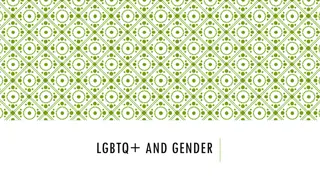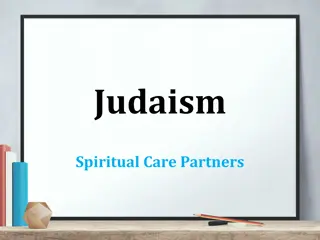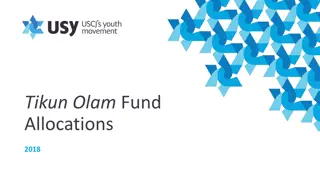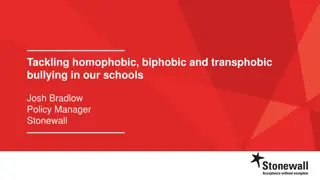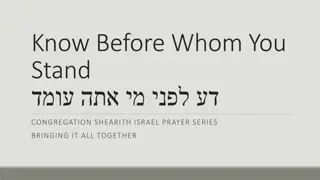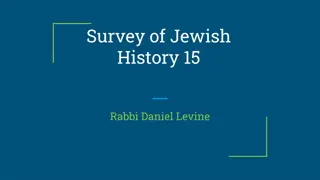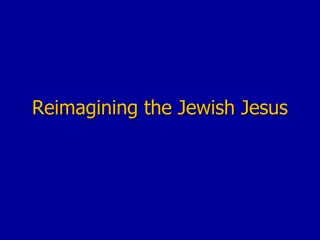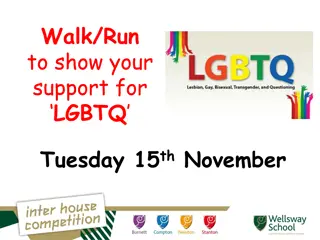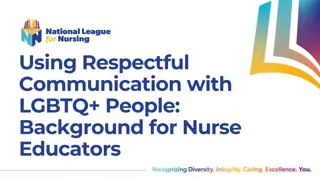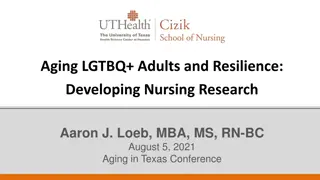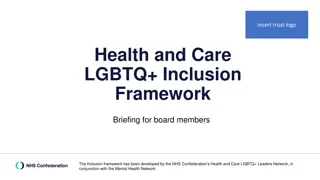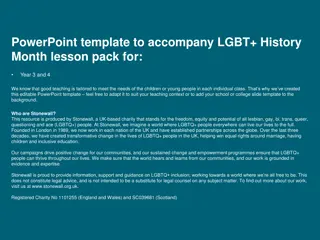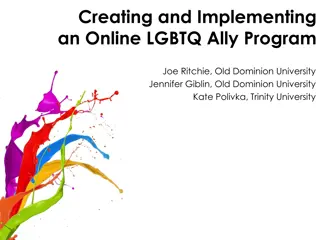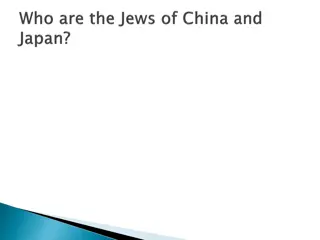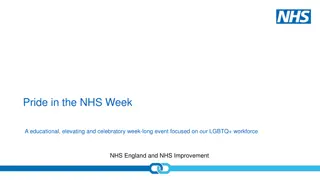Queering Orthodoxy: LGBTQ+ Perspectives in Contemporary Jewish Orthodoxy
"Exploring the evolving landscape of LGBTQ+ acceptance within Jewish Orthodoxy, this text delves into the intersection of religious tradition and sexual orientation in Israel. From conflicting views on homosexuality to the emergence of LGBTQ+ religious communities, the narrative reflects societal shifts and theological transformations that challenge orthodox perspectives. Through personal anecdotes and scholarly insights, the discourse navigates the complexities of identity, belonging, and inclusivity in a traditionally conservative setting."
Download Presentation

Please find below an Image/Link to download the presentation.
The content on the website is provided AS IS for your information and personal use only. It may not be sold, licensed, or shared on other websites without obtaining consent from the author.If you encounter any issues during the download, it is possible that the publisher has removed the file from their server.
You are allowed to download the files provided on this website for personal or commercial use, subject to the condition that they are used lawfully. All files are the property of their respective owners.
The content on the website is provided AS IS for your information and personal use only. It may not be sold, licensed, or shared on other websites without obtaining consent from the author.
E N D
Presentation Transcript
QUEERING ORTHODOXY: THE BATTLE OVER JUDAISM S (STRAIGHT) SOUL IN THE BATTLE OVER JUDAISM S (STRAIGHT) SOUL IN ISRAEL ISRAEL Orit Avishai, Fordham University Under contract with New York University Press
There is no such thing as a religious homosexual [Rabbi Shlomo Aviner, a conservative Orthodox stalwart. 2002] We have hommos. They are more numerous than you can imagine [Nati Epstein, co-founder of the Orthodox gay men s organization Havruta, writing anonymously in 2001] I stand before you as a messenger of a society that is stuck, frightened, confused, and bewildered. The Torah stands here beside me and says men shall not lie with men, it is an abomination. And my brother, who is standing here on the other side of me, says do not cast me aside, I am your brother. You hold the Torah in one hand and your brother in the other, and you try to find a way. [Benni Lau, Orthodox Rabbi and LGBTQ ally. 2019] Setting the scene We re not seeking to destroy the institution of the straight family. All we want is a room of our own within the Jewish home. There are lots of rooms, enough room for all. [Chaim Elbaum, Havruta activist. 2018]
AT TURN OF 21STCENTURY Homosexuality and religiosity seen as incompatible Religious LGBT persons portrayed as transgressive Few religious elite allies Mirrors situation across conservative religious traditions The difference two decades make BY 2020 Social and cultural shifts: a vibrant & visible Proud Orthodox Community (Kadag); younger people more likely to identify as both/and Theological shifts: first public acceptance of same-sex unions & families. Orthodox conservatives: take off your kippa
JEWISH ORTHODOXY Demographic group known in Israel as religious nationalist or religious Zionist; loosely tracks modern Orthodox in the U.S. In the process of fragmentation Product of a discursive process, not a node on an imaginary range between modernity and tradition; battles over definitions Context KADAG, THE PROUD RELIGIOUS COMMUNITY Loose collection of organizations and initiatives with distinct yet overlapping agendas, interests, and membership. Emerged in the late aughts A community and a social movement
LGBTQ ACCEPTANCE MOVEMENTS On the rise within a range of religious traditions and geographical locations Demonstrate significance of the local context Case study adds non Christian, non U.S./European lens Context
How marginalizedand until recently invisible and unfathomable persons negotiate the contours of religious lives when their bodies, identities, and desires defy their faith communities dominant ideas about gender, sexuality, and bodies. Research questions How did Orthodox same-sex attracted persons in Israel make their lives visible, legible, and palatable within two decades? What does this process tell us about Orthodoxy itself as a religious tradition and a social category? Who decides who and what is authentically Orthodox?
Theoretical setup
Lived religion implies that religious lives, beliefs, and actions are inherently messy, fluid, and ambiguous and that people do not uncritically absorb authorized versions of religious doctrines and messages Lived religion: an orienting lens Asks how people negotiate, make sense of, and live their religious lives. Provides an entry point for thinking about the encounter between LGBTQ persons of faith/from faith backgrounds and their religious communities, practices, narratives, myths, theologies.
THE SECULARIST BIAS OF SEXUALITY STUDIES Religion as blind spot in queer theorizing: religious actors seen as adversaries rather than as fellow travelers. (Religion vs. LGBTQ) Framework overlooks religious pluralism & transgressive potential of subversive religious voices Results in impoverished portrait of the lives, struggles, strategies, and desires of LGBTQ persons of faith. Taking religious seriously INTERVENTION: RELIGION IS/CAN BE Core identity aspect like gender, sexuality Productive force in lives of LGBTQ persons Central to LGBTQ movements and struggles; revealing them as not thoroughly secular endeavors.
THE IDENTITY CONFLICT FRAME Dominant in research with LGBTQ persons of faith Assumes a paradox, an identity conflict between religious & gender/sexuality; traced to several Biblical verses Ignores social, political context of religion The identity conflict and resolution frame Implies that individuals can resolve conflict on their own through identity integration INTERVENTION: Lived religion: meaning making journey, not conflict Solutions are systemic: new scripts that challenge prevailing ideas about Orthodox authenticity Scripts mobilize rather than reject religion Complicates encounter between LGBT persons and religion
Grounded theoretical approach 120 interviews open-ended with self-identifying Orthodox LGBT persons, activists, allies, educators, therapists, family members Methods Observations in ritual spaces, political activism, social gatherings, and community engagement Digital ethnography: Facebook pages of Orthodox LGBT persons, allies, organizations and initiatives Analysis of archival material
LGBT VS. LGBTQ+ I use LGBT in the context of Jewish Orthodoxy since most of my respondents use a Hebrew acronym that excludes queer I use LGBTQ+ to refer to gender and sexual variance in other contexts to reflect scholarly linguistic norms. Generational shift: younger persons are beginning to identify as queer. Terminology HOMMO: NOT AN EPITHET IN LOCAL CONTEXT Many Orthodox gay men in Israel identify as homosexual/ hommo. In local context hommo is subversive: mainstream Orthodoxy refers to homosexuality as inverse tendency that can be cured, while gay is associated with secular culture.
Core wishes of Orthodox LGBT persons: attend educational institutions of their choice; find a partner to whom they are attracted emotionally, physically, and romantically; align their physical body with their gender identity; send their children to neighborhood schools; live amongst their friends and family; and feel welcome in the synagogue and Beit Midrash (learning community) Many identify with religious Zionist political causes but resent this camp s political leaders homophobia The subversions of everyday life Most do not take to the streets, join Kadag organizations, or come out on Facebook Through the choices they make about who to love, how to live in their bodies, where to locate their nontraditional families, and how to worship they partake in the grand experiment of queering orthodoxy: disrupting taken-for- granted ideas about authentic Jewish families, bodies, and manifestations of live.
Dominant frame: LGBTQ+ persons encounters with faith traditions and religious communities center on the concepts of paradox, identity conflict, and incongruence Orthodox hommos and lesbians experience conflict but also mourn shattered picture of a normative Orthodox adulthood Mobilizing religion to devise new scripts Devise scripts and theologies of self, relationships, family life, and what it means to be Orthodox New scripts are rooted in the Jewish tradition Just live their religious lives as they fit
Encounter between faith and LGBTQ+ persons not only source of conflict & pain, can be productive: resulting in new ideas about religion, religiosity, a religious people A productive encounter (beyond identity conflict) Orthodox LGBT persons inadvertently become conduits of religious change
MAKING SPACE Kadag Operates through inward-facing initiatives that create safe spaces and outward-facing public education initiatives and visibility campaigns Goal: make space for Orthodox LGBT persons within Orthodoxy Strategy: claims of Orthodox authenticity. Stories, public spectacles draw on Orthodox language, sensibilities, rhetoric Activism PARADOX? Kadag draws on strategies and tactics from standard LGBTQ+ activist playbooks but deploys Orthodox language, rhetoric, sensibilities, and political affinities.
Theology, religious jurisprudence not typical arena for LGBTQ+ battles which are more frequently focused on freeing sexuality from regulation not seeking new forms of surveillance Kadag activists turned theology into a battleground because of its centrality to Orthodox Jewish life First theological shift: from theology of transgression (homonegative position) to a theology of tolerance Theology as an arena of activism But tolerance is not enough, doesn t recognize full Jewish personhood Making space involves new, homopositive theological stances LGBT Orthodox Jews harness, mine, mobilize the tradition s own logics, language and sensibility first to make sense of themselves, then to demand that communities make space. Produce a theology that worked from the ground up
Challenging Orthodoxy: by partaking in developing a new theological stance, challenging very definition and boundary of Orthodoxy and authority structures Theology as an arena of activism Dispute is not only theological: gulf between tolerance and transgression reflects a deeper chasm between those who view modernity as an existential threat and those who view it as a challenge that will propel Orthodoxy forward.
KADAGS ACTIVISM ISNT RADICAL Reluctant dissenters who work to make space from within the tradition, not start a revolution For the most part politically aligned with nationalist goals Queer theorists are skeptical of political campaigns premised on sameness and inclusion (homonormative & homonationalist) A politics of complacency? ORTHODOX CONSERVATIVES ARE ALARMED Escalating anti-LGBT rhetoric Claims that LGBTQ identities are un Jewish and un Orthodox Suggesting that impact is potentially radical. Hence the title queering Orthodoxy
LGBT persons threat resides in activism and in everyday lives that defy normative messages, very presence and visibility within families, synagogues, neighborhoods, schools, and social media New ideas are dangerous! LGBT persons destabilizes once taken- for-granted positions about gender, sexuality, science, and authentic forms of Jewish family life. A radical potential? Demonstrates that what it means to be an Orthodox Jews, a person of faith Orthodoxy itself is constructed, unstable, negotiated, contingent, and therefore potentially subversive. Takeaway: story is not only about individuals who navigate hateful faith traditions but also about how they reshape these traditions. Despite politics of complacency the challenge to very category Orthodoxy can be read as a quintessentially queering project.
Orthodoxys troubles do not center on LGBT issues, but they coalesced here: on the one side a liberal Orthodoxy (reluctantly?) coming to terms with contemporary realities, on the other a reactionary Orthodoxy seeking to protect itself by erecting ever more stringent boundaries. Implications for Jewish Orthodoxy Kadag battles, Orthodox LGBT experiences reveal the extent to which Orthodoxy is constructed, malleable, and historically contingent. Battle is over Orthodoxy s soul, waged on the backs of people who just want to live their lives.
What can we learn from a religious LGBT movement that occupies a liminal space between queer disruptive politics, visions, and tactics and a desire to affiliate with a (purportedly) timeless faith tradition whose origin myths are hostile to queer existence and possibilities? Taking religion seriously! Thinking about religious communities from their margins reveals the ideological, cultural, and historically contingent work that goes into producing (and protecting) the collective Larger takeaways As individuals confront, challenge, and negotiate with religious edicts, they undermine authorized forms of religion, thereby exposing the malleable, constructed nature of religiosity
